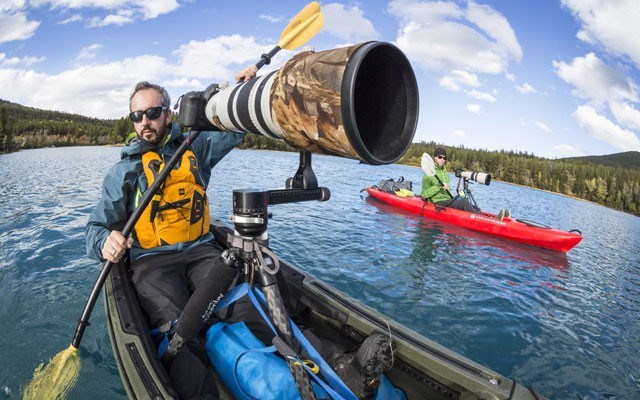Dan Carr doesn't consider himself a wildlife photographer, but taking photos of grizzly bears has always been on his long to-do list of photographic subjects.
"I look at a lot of photography from all different genres, and I've spent many, many hours looking at wildlife photography from other people," said Carr, who launched his career as a ski photographer in Whistler 10 years ago.
"I kind of knew the behaviour (of the bears) that I was looking for, the behaviour that was going to produce a good photo, but this was my first proper wildlife photography expedition."
The grizzly bears of British Columbia are much adored by travelling nature and wildlife photographers, so in order to get unique images for his photography magazine clients, Carr needed a fresh approach.
"It's pretty different to the kind of thing I've done before, but I didn't want to go up there, stand around and hope that (the bears) came to me," he said.
"I wanted to feel a part of their environment as much as I could and I wanted the photos to reflect that. One of the shots I wanted was a bear eating a salmon in the water, it tells the story of why they're there, which is because of the salmon run."
Carr's idea was to travel deep into grizzly bear country in the Chilcotin Mountains — about half way between Williams Lake and Bella Coola — and shoot grizzlies in their native river habitat from a kayak.
But as creative as the idea was, a burning question of practicality was raised: How do you keep $20,000 worth of photography equipment safe and dry in a small watercraft?
"I did some research into what kayak would be the most stable, and bought one specifically for the trip and figured out how it was going to work. There was no one I could find who had come up with an effective way to do that yet," said Carr.
"People have shot grizzly bears from boats a lot, but being in a kayak makes you a little bit lower and a little more manoeuvrable."
While kayaks built for touring and whitewater can be easily rolled over — soaking its pilot and that person's belongings — Carr found the solution with a Wilderness Systems Commander 120. This craft is a canoe-kayak hybrid that has an open design for carrying lots of equipment, as well as a twin-hull — kind of like a mini catamaran —making it exceptionally stable.
"It's actually a fishing kayak, those are great because they're built for stability, so you can actually stand up and cast in them," said Carr.
"It's also got depth to it, so I can put my tripod inside it, rather than on top of it."
The rig looked like it would work, but with the safety of a lot of expensive electronics at stake, a "dry" run was needed. Well before departure to the Chilcotins, Carr tested the setup and mounting techniques of the kayak extensively on the relatively still waters of Green Lake in Whistler. With the confidence that he could paddle up and down a slow moving river, and have a stable platform to shoot from, Carr took off into the Chilcotins for two weeks in search of grizzly bears and was later joined by Whistler photographer Rowan Thornton. The initial plan was to move between several different camps over the two weeks, but Carr soon realized that he needed a longer time to learn certain bears' movements and catch them at the opportune time around feeding. The more days they spent with the same bears, the easier it was to pick which ones were the most comfortable around people.
"You want (the bears) to be aware of your presence, but once they acknowledge you, you don't want to make them overly aware, so there's a balance to be found," said Carr.
"Once they were aware of us we tried to be fairly discreet as we hung around with them. But they were almost universally not bothered, they were pretty busy doing their thing and eating dinner. As long as you're respectful of keeping (your) distance, of course, especially when there's cubs around."
Carr generally stayed between six to 12 metres (20-40 feet) away, while photographing grizzlies on the shore from his kayak. He was surprised at how much time they actually spend in the water.
"I was quite fascinated by them once they were in the water, it's not how you see them a lot of the time," he said.
"They really like to get in there and sometimes would just lie down whirl around in the shallows. Sometimes they would cross the river and swim alongside us."
At one point near the end of the trip, Carr and Thornton teamed up with another pair of wilderness photographers and with the added safety of numbers in their group, decided to photograph three grazing grizzly cubs while standing on land, just 10 metres (30 feet) away.
"One of the cubs bluff charged us," said Carr.
"It was the only time on the trip where I reached for my bear spray and flipped the lid open. It was basically unheard of for a group of four people to get attacked, so we were a little more comfortable with the situation. But still, it was the only time when I felt apprehensive, He was quite aggravated and even though he was two years old, he was big enough to take you down."
To view Dan Carr's portfolio head to dancarrphotography.com or follow him on Instagram @dancarrphoto




